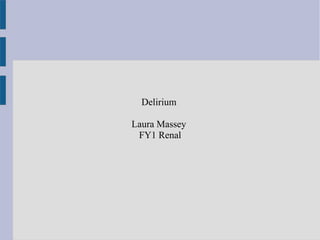
Delirium Diagnosis and Treatment
- 3. Delirium definition Inoye et. al 1990 ¹ Must be: − Acute onset + fluctuating course − WITH Inattention − Plus either/ or − Disorganised thought content − Altered GCS
- 4. Delirium Types Hyperactive – restless, agitated, swearing, non-cooperative with routine tasks, wandering, hallucinations – often visual, poor concentration, poor appetite, rapid personality change Hypoactive – sleepy, withdrawn, 'like they're not there', poor concentration, poor appetite, rapid personality change Mixed
- 5. How many inpatients get delirium?
- 6. How many inpatients get delirium? Approximately 30% of all older adult inpatients² − 10% if all ages taken into account Higher in intensive care environments Anywhere between 10->50% of older patients who have had surgery, most affected are those with; − Fractured NOF − Vascular patients
- 7. Assessing the person ABCDE!!! − ABG − ECG − CXR − Routine set of bloods If severe pain consider Ix for this e.g. CT abdo Consider urinary retention – palpable bladder/ scan Consider constipation – PR Abbreviated AMTS /4 if drops a mark proceed to the full 10³ − Age, DOB, place, year Day team may want to consider further collateral Hx, MMSE/ ACEIII if appropriate
- 8. How to treat Good nursing technique, be reassuring, gentle redirection, well lit rooms, clocks easily visible, visual and hearing aids available. TREAT THE CAUSE – pain/ infection/ constipation commonest Medication is a last resort – oral preferable to IM, IV not in trust guidelines. − Lorazepam 0.5mg PO/ IM max 2mg per day – be wary in renal failure − Haloperidol 0.5mg PO/ IM max 2mg per day Contraindicated LBD/ Parkinson's, avoid in those with alcohol excess Be patient it can take 6 weeks or more to resolve
- 9. Good Sources of Information Connect Guidelines NICE guidelines for delirium British Society of Geriatrics website − Good powerpoint on post-operative delirium Royal College of Psychiatrists Website http://www.uptodate.com/contents/delirium-beyond-the-basics Has excellent info sheets for carers and families. Seniors, other experienced colleagues – nurses/ OT/ PT, SAFE team, psych liaison.
- 10. Summary Delirium is common and as an FY1 you should be vigilant in looking for the signs Explore the cause, and treat appropriately Always try to reassure and redirect, encourage others nursing for the patient to do so Medication is a last resort, and avoid intravenous medication to avoid delirium If concerned about a patient – ABCDE Never be afraid to ask for help – they're paid more to help you make decisions!
- 11. References 1. Inouye, S.K. et. Al Ann Intern Medicine 1990 113:941 2. 3. Swain D.G, and Nightingale P.G, Clin Rehab 1997 Aug 11(3): 243-8 http://www.uptodate.com/contents/delirium-beyond-the- basics